We all know that routine maintenance is important for everything from our computers to our cars. But sometimes, we fall short. One of the most neglected routine car maintenance tasks is to check tire pressures and inflate them as necessary. That’s why newer cars have tire pressure warning lights, or tire pressure monitoring systems (TPMS), that let you know when you have under- or over-inflated tires (when any tire is 25% underinflated).
Older vehicles don’t have this useful warning light. So, don’t wait for a rupture to check or change a tire. Use this guide to learn how to check the pressure (PSI) of your vehicle tires and how to inflate them to the proper air level.
Why should you check your tire pressure?The number one reason why you should periodically check your tire pressure is SAFETY, but there are monetary and handling reasons as well:
Proper tire pressure (as recommended by the manufacturer) is needed to drive safely and efficiently. According to a 2009 report by the National Highway Traffic Safety Administration:
“…about 28% of light vehicles on our Nation’s roadways run with at least one underinflated tire. Only a few psi difference from vehicle manufacturer’s recommended tire inflation pressure can affect a vehicle’s handling and stopping distance. Poor tire maintenance can increase incidences of blowouts and tread separations. Similarly, underinflation negatively affects fuel economy.”
When your tires are underinflated, the tires get fatter, increasing their surface area. This causes high heat generation and extra resistance that could result in higher fuel costs, blown out tires, tire wear, and loss of control.
If you feel like you’re spending too much at the gas pump, it might be your tires. According to the US Department of Energy:
“You can improve your gas mileage by 0.6% on average—up to 3% in some cases—by keeping your tires inflated to the proper pressure.
Under-inflated tires can lower gas mileage by about 0.2% for every 1 psi drop in the average pressure of all tires.”
In addition to safety and fiscal concerns, keeping your tires properly inflated will also reduce your impact on the environment. When your tires are properly inflated, you’ll pay less for gas, replace your tires less often, and improve your handling and stopping distance. You’ll also feel better knowing that you are emitting less carbon dioxide and other harmful substances into the atmosphere.
What is the right PSI level?PSI stands for pounds per square inch. The recommended PSI for your vehicle’s tires is determined by the vehicle’s manufacturer and the recommended tire size.
One big question that we get is whether you should follow the recommended PSI level on the tire itself or the recommended PSI level printed in your owner’s manual or on the placard inside of door edge, glove box door, or fuel door.
Do NOT use the max PSI that is printed on the tire sidewall. This is not the recommended PSI level. The pressure amount on the tire is normally the maximum allowed pressure. The correct PSI level is almost always less than what you see printed on the side of the tire. Over-inflation can lead to poor handling and comfort, overheating and blow outs. Over 40 PSI is a dangerous level for most vehicles!
Make sure you always use the recommended PSI as provided in your owner’s manual and don’t go any more than 5 PSI over the recommended level. You should make sure, however, that your tires are appropriate for your vehicle. You can do this by checking the car’s owner’s manual or the placard that is on the inside of the driver-side door, glove box, or fuel door.
Most car tire pressure recommendations range from 30-35 PSI.
How often should I check tire pressure?A question in many minds is when is the appropriate time and frequency for checking and inflating vehicle tires.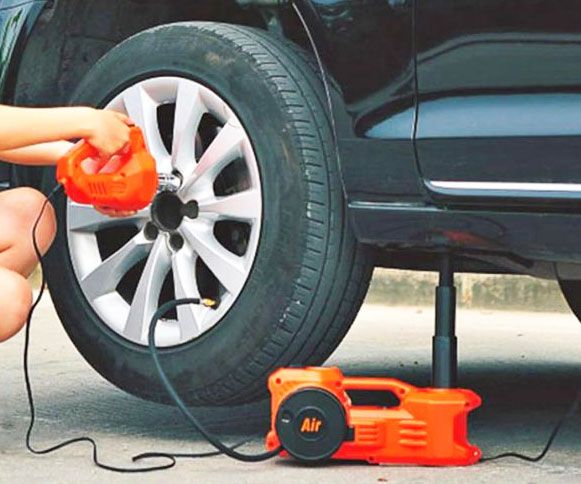
A quick google search will reveal a variety of different opinions and suggestions. Some say that you should check your tire pressure every 2nd visit to the gasoline station, while others say once every 3-6 months is OK.
Most tire and vehicle manufacturers, on the other hand, will say that you should check your tire pressure at least once every month, or every second trip to the gas pump. Your tires will lose around 1 PSI each for every month that goes by.
Unfortunately, not one answer will fit every situation. There are several factors that influence how often you should check your tire pressure, including:
Did you know that for every 10°-drop in temperature, you lose 1 pound of pressure?
If you have a leaky valve or a small puncture, you will lose air pressure much more quickly. This is one more reason why you should frequently check the tire pressure on all of your tires.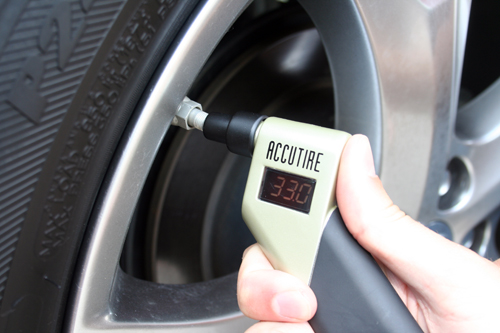
Since tire pressure constantly fluctuates, it’s important to check it periodically (at least once a month) and add air as necessary.
How to Check Tire PressureFinding out the tire pressure of your tires is incredibly easy. All you need is a pressure gauge (click here for additional items you should have in your vehicle).
Just make sure that you are checking your tires when they are relatively cold. If you check your tire pressure after a long drive, you will get an inaccurate reading since heat will temporarily increase the tire pressure reading.
Unfortunately, not all pressures gauges are created equal. Some are better than others. We recommend shelling out a couple extra bucks for a digital reader. The pop-up, stick-type versions are notoriously inconsistent and unreliable. A reliable gauge will be well worth the investment. Prices range from about $5 for the stick-type and about $30 for the digital and dial-type pressure gauges.
You can also check your tire pressure at most gas stations or auto repair shops. Discount Tire offers free tire pressure checks and inflation.
Here are the steps for checking your tire pressure: Check the tire pressure again. Release more air if necessary. If you release too much air, you can always add some air back.
Check the tire pressure again. Release more air if necessary. If you release too much air, you can always add some air back.It should only take you a couple minutes to check the air pressure of your vehicle’s tires. As soon as you restore tire pressure to the recommended levels, you’ll start experiencing the safety and savings that come with this regular maintenance task.
Watch this video for more information on how to check your tire pressure:
How to Inflate TiresHere are the steps for adding air to your tires:
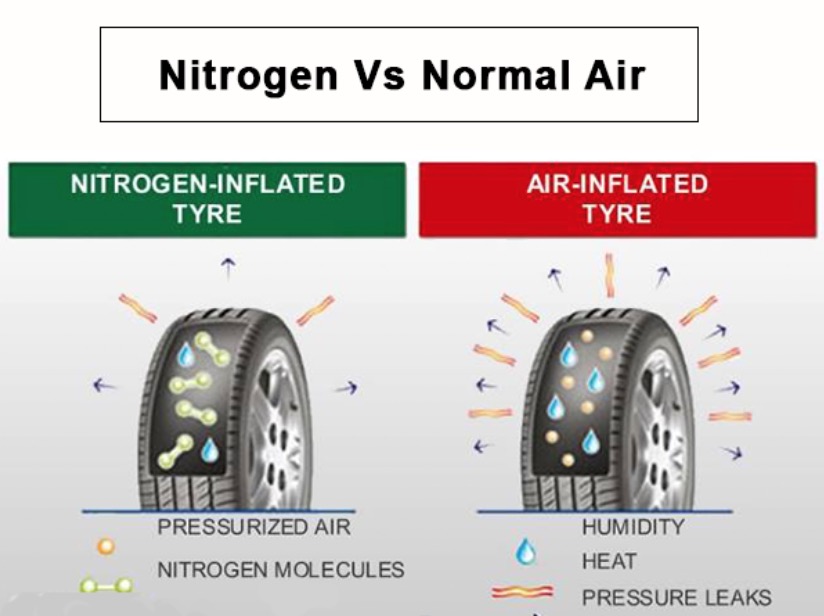 Instead, go to your local gas station that has a coin-operated air pump (ask the attendant if you can’t find it). You can also purchase your own automatic air compressor, but it will cost you around $50-$150.
Instead, go to your local gas station that has a coin-operated air pump (ask the attendant if you can’t find it). You can also purchase your own automatic air compressor, but it will cost you around $50-$150. Hold it firmly against the valve as you listen to the air filling the tire.
Hold it firmly against the valve as you listen to the air filling the tire.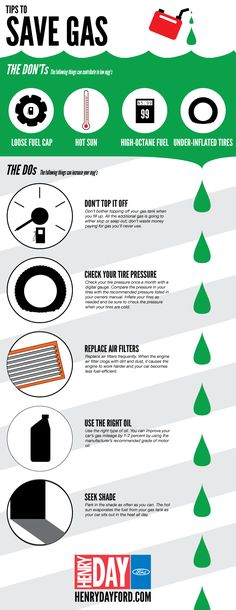 You’ll want to screw them back on now.
You’ll want to screw them back on now.Remember, just one drop in PSI can lower your gas mileage by about 0.2%. For every 3-4 PSI units that your tire is underinflated, you are burning around 1% more fuel.
If your tires are flat, then you probably have a leak. Add air and see if you can drive around without the pressure dropping. If you hear air escaping the tire while you are filling up, then it’s time to replace the tire.
Tip: Learn how to use the air pump properly first. Some automatic air pumps at gas stations have a handle/switch that you need to depress in order for the air to flow. When you let go of the handle, a tire pressure gauge will pop out showing you the tire pressure. At the same time, air will be slowly released. If your air pump has this kind of handle, then you will want to hold down the handle for most of the time, periodically releasing it to check the pressure reading. Consult your own tire pressure gauge for accuracy.
When should I replace my tires?If you check your tire pressure at least once a month as recommended, you’ll also get a good idea of the general condition of your tires and when you should replace them.
We recommend using the penny test:
Source: bridgestonetire.com
Click here for more car maintenance tips. Click here for car winterization tips.
Auto Simple wants you to find a vehicle you love at a price you can afford. We carry a large selection of hand-picked, Certified Pre-Owned vehicles, all with a 6 month/6,000-mile Powertrain Warranty.
If you have any questions, don’t hesitate to speak with one of our Online Specialists or give us a call:
Chattanooga, TN – (423) 551-3600
Cleveland, TN – (423) 476-4600
Dayton, TN – (423) 775-4600
Dalton, GA – (706) 217-CARS (2277)
Follow us on social media for more useful information on buying, selling, and maintaining vehicles: Facebook, Twitter, Youtube, and Google+.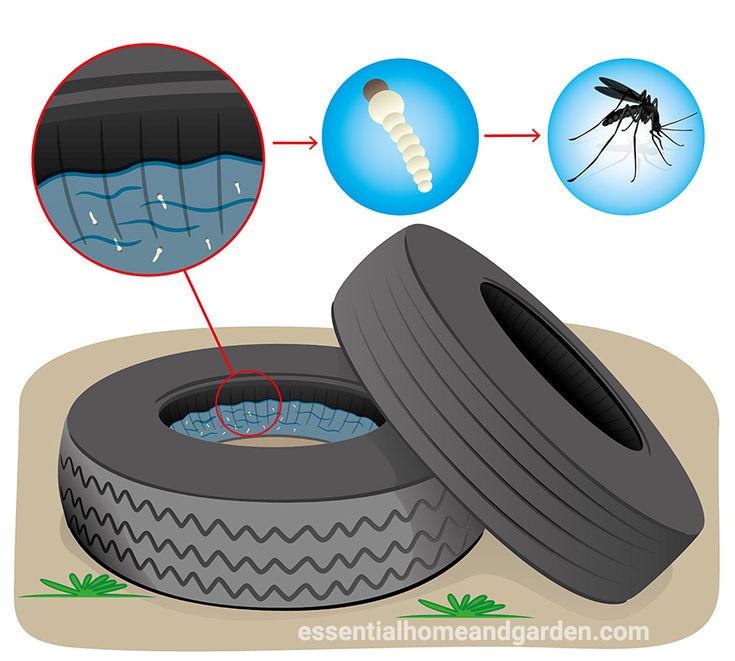
Your car's tires play many valuable roles in the safety and function of your vehicle — from helping you navigate twists, turns, and stops like a pro to carrying the full weight of your car. That's why it's important to pay special attention to these essential components.
Fortunately, maintaining the proper tire pressure on your vehicle is one of the easiest yet most effective ways to care for your car tires. Learn how to check air pressure and inflate your tires with this helpful guide.
Underinflated tires can not only reduce fuel efficiency, but it can also run the risk of getting into an accident, losing proper steering control, damaging various components of your vehicle, and more. If you notice that your tire's air pressure levels have dropped, it's best to prioritize inflating them as soon as possible.
Checking your vehicle's tire pressure is a relatively simple task. You'll want to start by purchasing a tire gauge. These vary in price depending on the type you choose (i.e., digital, basic, etc.) but can usually be found for well under $40. It's also essential to keep a tire gauge on hand, as some gas station air hose gauges are not always accurate. Many modern cars and trucks also display the tire pressure for each tire on the dashboard. Once you have your tire gauge in hand, it's time to determine the proper pressure for your vehicle.
You'll want to start by purchasing a tire gauge. These vary in price depending on the type you choose (i.e., digital, basic, etc.) but can usually be found for well under $40. It's also essential to keep a tire gauge on hand, as some gas station air hose gauges are not always accurate. Many modern cars and trucks also display the tire pressure for each tire on the dashboard. Once you have your tire gauge in hand, it's time to determine the proper pressure for your vehicle.
Find the correct inflation level. To do this, you can either look for the recommended pressure on the sticker within your driver's-side door jamb or consult your car owner’s manual. This is the tire pressure specification when the tires are cold, meaning not driven for a few hours.
Remove the valve stem cap from your tire. Some cars and trucks have green valve stem caps with an “N” on them - this means the tire is filled with nitrogen instead of air (air is mostly nitrogen). If your tires have these green valve stem caps, you can find some special stations that dispense nitrogen, but be aware that you can use normal air as well. The inflation pressure specifications are the same regardless if the tire is filled with air versus nitrogen.
The inflation pressure specifications are the same regardless if the tire is filled with air versus nitrogen.
Connect your air pressure gauge to the tire’s valve stem until you receive a reading.
If the pressure level number seems unrealistic, remove the gauge and try again. This time, ensure that the indicator is connected firmly to the valve stem.
It's not always possible to tell if a tire is underinflated by giving it a quick once over. So, check your PSI levels with a gauge each month and after extreme temperature changes. You'll also want to check your pressure levels when your tires have had time to cool down since air expands within your tires while driving.
Filling your tires with air at a gas station is relatively simple. Bring your tire gauge and some spare change since some are coin-operated and are not always accurate in their pressure readings. Try to make this the first stop if you are running errands so that your tires are still relatively cool from sitting for a few hours. Then, follow these steps:
Then, follow these steps:
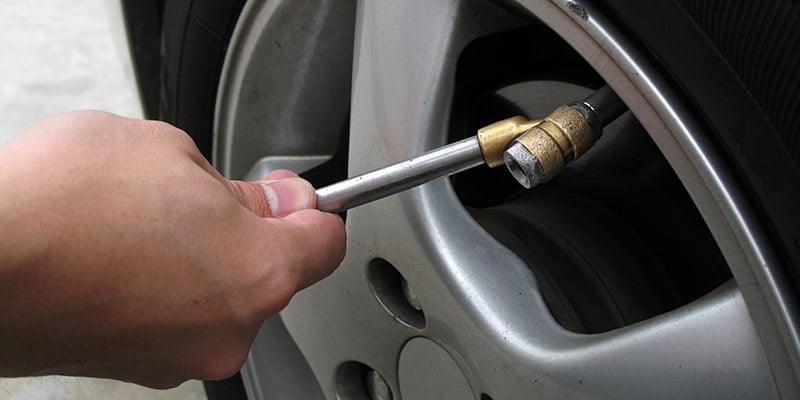
Can't find an air filling station near you or just want some help? Head to your local Firestone Complete Auto Care. We'll give you a free tire inspection and refill your tires free of charge. And if you need new tires, we've got you covered there too!
Let's look for answers to questions about the benefits of inflating tires with nitrogen (N) rather than compressed air. Does this make the car more economical, and the movement on the road is smoother, will the service life of such tires increase.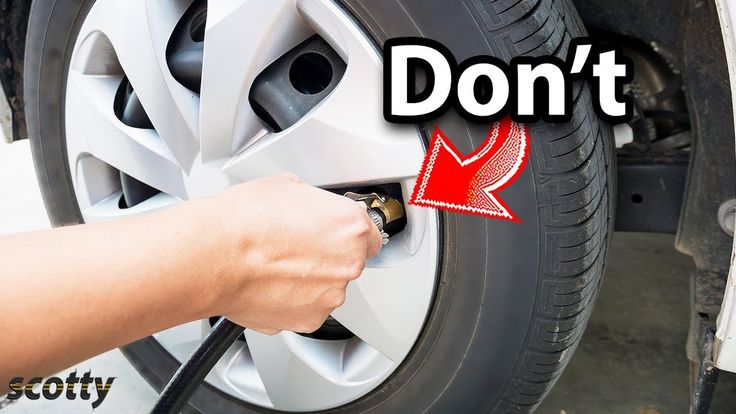
In short, the answer is: something like that.
Air is 78% nitrogen, 21% oxygen, the rest is water vapor, CO2 and a small concentrate of noble gases (neon, argon, etc.)
Compared to oxygen, nitrogen is less fluid, so less evaporation into the atmosphere through cracks in rubber, i.e. tire pressure will remain stable. Sports car drivers love tires filled with nitrogen, as they are less susceptible to temperature changes, so the pressure in them does not change much. This is a plus in races where tires overheat quickly due to high speeds. In tires with nitrogen, despite the heating of the tire, the pressure increases consistently, without jumps, which improves the predictability of sliding and the behavior of the car in the race.
For reasons that will be described below, moisture often gets inside the wheel. Moisture inside the tire is detrimental to tire pressure.
Water in the form of vapor or liquid has a greater effect on changes in tire pressure under conditions of temperature difference than dry air.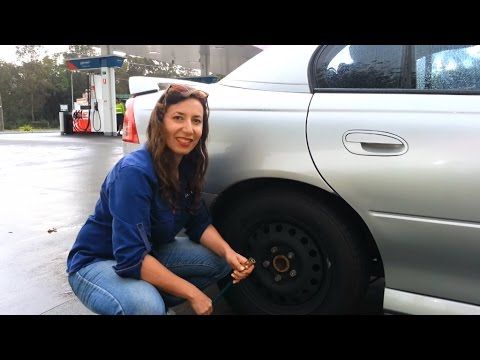 Moisture corrodes the steel or aluminum rim of the disc, the tire cord - the elements of the car wheel.
Moisture corrodes the steel or aluminum rim of the disc, the tire cord - the elements of the car wheel.
To check if there is moisture in the tire, unscrew the cap of the nipple (nipple) and release some air by placing your finger on the valve. If your finger gets wet, then there is moisture in the tire. The reasons for its appearance are most likely in unscrupulous tire fitting workers who do not serve the air system that the car wheels are pumped up with. Moisture not eliminated from the air system gets inside the wheels.
Another cause of moisture in the wheel can be water-based tire lubricants, which are applied to the inside edges of the tire to be installed on the rim. If, after applying such a lubricant, you do not allow the wheel to “sunbathe” in the sun for a couple of hours and only then pump the tire with air, moisture inside the wheel cannot be avoided.
The beauty of nitrogen is that it prevents moisture from entering the tire when it is inflated. Any system that will inflate tires with nitrogen will supply it there in a completely dry form. When pumping, nitrogen is filled and blown through the wheel several times in a row, successively diluting the oxygen concentration in the tire. This prevents moisture from accumulating inside the wheel.
When pumping, nitrogen is filled and blown through the wheel several times in a row, successively diluting the oxygen concentration in the tire. This prevents moisture from accumulating inside the wheel.
Filling tires with nitrogen is not technically difficult, but time consuming. Tire changers inflate tires with a machine that creates near-pure nitrogen with minimal oxygen addition and automatically performs multiple inflation cycles. The cost of pumping one wheel is 200-250 ₽, depending on the size.
The wheel inflation mixture offered at service stations will consist of 95% from nitrogen and 5% from oxygen, that is, the difference in the concentration of nitrogen in this mixture with pure oxygen is about 15-20%. This ratio is standard. The danger lurks at unscrupulous tire stations, where, due to cheap or broken equipment, the nitrogen mixture will consist of 85-90% nitrogen and 15-10% oxygen. The advantages described above will not come from such a mixture.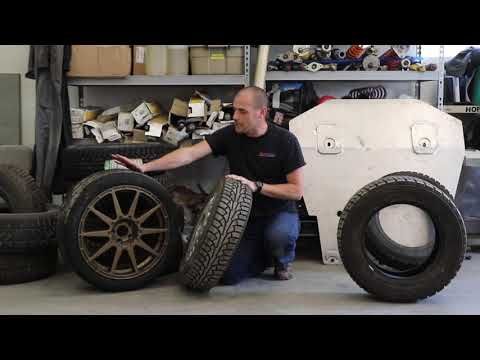
Do not believe that nitrogen wheels are lighter than air wheels, so the car becomes more economical. At the same temperature, dry air and atmospheric pressure, 1 cu. a meter of air weighs 1.29kg., and nitrogen 1.25 kg. In a wheel with a diameter of 14-15 inches, the weight of air is approximately 0.0774 kg, and nitrogen 0.075 kg, that is, a difference of 10 grams. Such a small difference in weight will not affect the economical fuel consumption of the machine.
We dismiss the myth of improved handling - you will not feel any difference. We also rule out the myth that tires with nitrogen are lighter, and this saves fuel - it doesn’t save, because it’s not lighter.
In the future, the question of how best to inflate tires will be removed by itself, as airless tire solutions begin to appear on the market, for example, Bridgestone. True, only in the prototype, but Zap-Online.ru cherishes the hope of seeing the concept on production cars.
True, only in the prototype, but Zap-Online.ru cherishes the hope of seeing the concept on production cars.
The tire is one of the most important car parts. Naturally, it needs proper supervision, otherwise you risk lowering the level of safety when driving. In the previous article we talked about ways to easily get out of a situation with a puncture. In this section, we will talk about the positive and negative aspects of inflating tires with nitrogen. Everyone has heard about the positive aspects of this method of creating tire pressure, but rarely even thought about trying it on your car.
Benefits of nitrogen
It should be noted that oxygen (the gas we use to inflate tires) tends to change its volume with a sudden change in temperature. Compared to nitrogen, this figure differs six times! It follows from this that if you pumped up the tires of a car with oxygen to the level of a cool garage, you will not provide the highest level of safety.
With a sharp increase in temperature, and even on hot asphalt, the pressure in the tires rises sharply, the center of the tread becomes convex relative to its edges, as a result, the tire wears out faster. Conversely, if you leave the garage in winter, then there is a chance that the pressure in the tires will drop so much that the center of the tread can collapse into the inside of the tire, this will lead to the inevitable destruction of the tire. In either case, you risk losing control of the car on the road.
Another important fact is that nitrogen in a punctured tire will not immediately relieve pressure. Let the difference be small, but these fractions of seconds can be decisive in extreme situations. Also, the pressure drop in tires with nitrogen is not as noticeable as with oxygen. It is worth remembering that nitrogen allows you to feel less bumps in the road. This gas helps to reduce tread wear, increases traction on asphalt by increasing the contact patch and makes the ride more comfortable.
Nitrogen has the advantage of not being corrosive. Unlike nitrogen, oxygen contains more vapors and is able to form condensate with a sharp change in temperature. Seeping through the rubber, it damages the metal fibers of the wheel, thereby reducing the service life. But there are those who claim the opposite - pumping only with nitrogen can reduce the life of the wheel.
Now let's talk about the cons. First of all, this gas is much more expensive than oxygen. Plus, it's a fairly rare gas, which creates a problem if three tires are inflated with nitrogen and the fourth has to be pumped with oxygen. You also need to be sure that your wheels do not lower, otherwise you will have to constantly pump up.
| What is the XL marking on a tire? XL (Extra Load) - marking on the tire, which literally means "extra load". This indicates that the tire is designed for more weight than standard rubber. 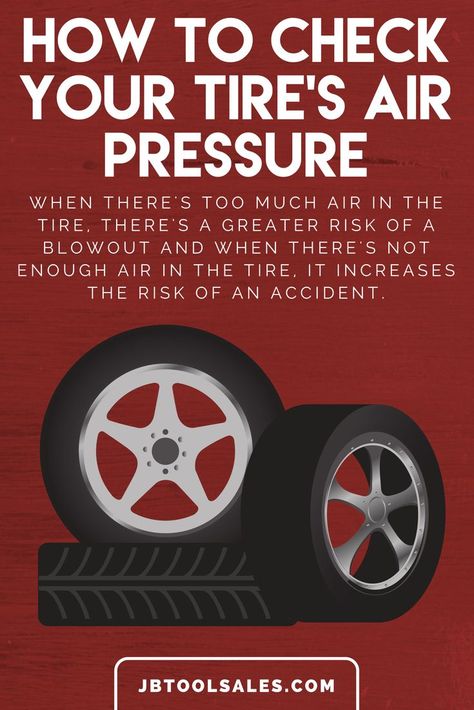 . . February 23, 2023, 15:32 | |
| What winter tires to buy? Expensive or cheap? To begin with, it is worth knowing the division into classes of car tires. It is useful to know when to buy expensive premium tires and when to choose cheaper analogues from the economy segment... 06 September 2022, 10:06 | |
| Tires for electric vehicles - which ones to choose? Driving an electric car is different from driving a car with an internal combustion engine. This is felt by both the driver and passengers. For tires, another type of drive is also important. Rubber on.. August 09, 2022, 11:58 | |
| Who are low profile tires suitable for? Car wheels are the first thing that comes to mind in the context of visual tuning.  | |